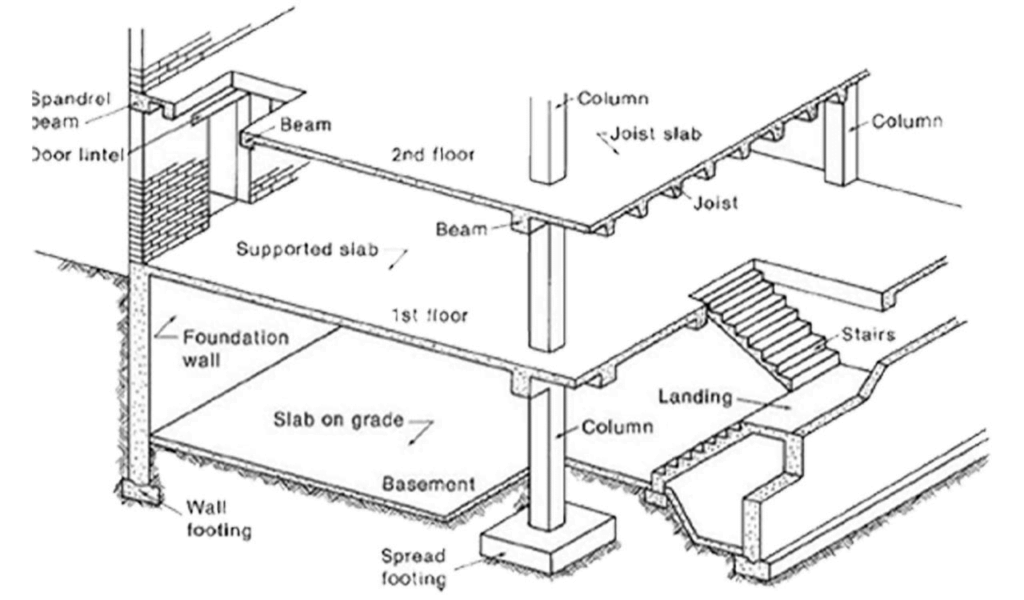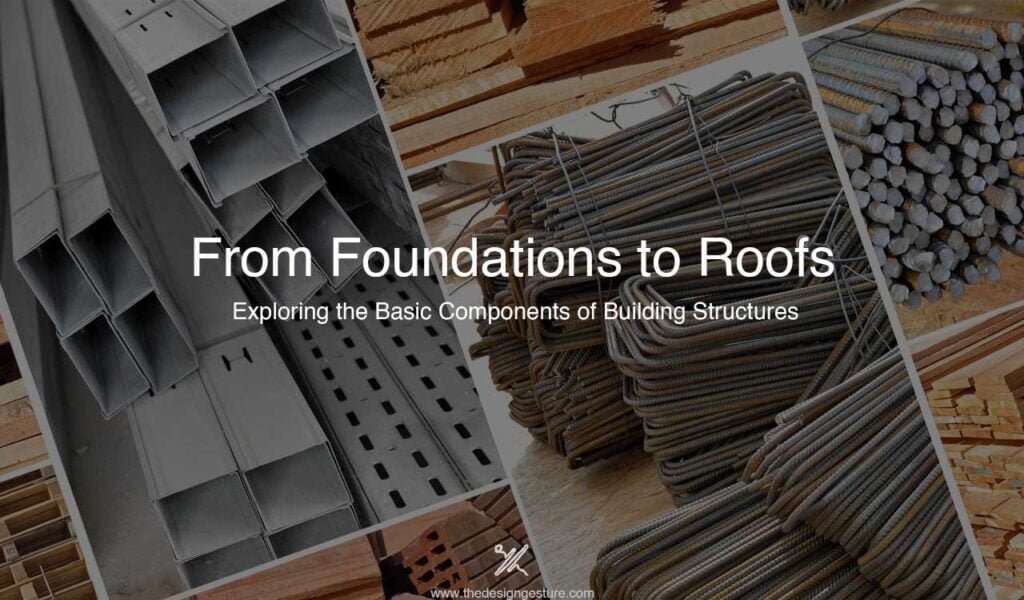The fundamental parts that are involved in making a structure are called building components. They are the basic elements of every construction because they are in charge of a building’s overall strength, durability, safety, usability, and aesthetic appeal. Each sort of building component employed in different structures has a certain function. We’ll talk about different types of building components and how they’re used to construct structures in this article.
Table of Contents
Different Type of Building Components
The different types of building components include the following:

Foundation
The lowest most component of a building structure that is in contact with the earth directly is the foundation. As it supports and carries the weight of the entire building to the ground, it is the most important structural component. It should be sturdy enough to handle the weight of the building, the load of the residents, and any outside factors like wind, earthquakes, and floods. Typically, it is composed of concrete, stone, or brick.
The support of constructions can be provided by a variety of foundation types. The three most common types are pile foundations, shallow foundations, and deep foundations. Smaller buildings frequently have shallow foundations, but larger structures or those constructed on unstable soils frequently have deep or pile foundations. The type of foundation used depends on the height of the building, the soil conditions, and the construction codes. A solid foundation ensures the stability and security of a building over the long run.
Walls
Walls are vertical construction components that divide and confine a building’s interior space from its outer space. They serve to protect the roof and floor constructions from weather conditions including wind, rain, and temperature in addition to sustaining the roof and floor constructions. Walls provide structural stability as well as protection from the elements, noise, and fire. They could be made of brick, concrete, metal, wood, or another material.
The sort of wall used in the structure depends on its use as well as the local climate. For instance, reinforced concrete is used in the walls of buildings in earthquake-prone areas so that they can withstand the lateral forces that an earthquake causes. The location and kind of structure also have an impact on the wall thickness. For instance, to maintain the warmth of the structure in cold areas, thicker walls with insulation are needed.
Columns
The weight of the building is supported by columns, which then carry that weight to the foundation. They can be cylindrical, square, or rectangular in shape, and are typically built of wood, concrete, or steel. They are strategically positioned within the building structure. To support the floor and roof constructions, columns are positioned at regular intervals along the building’s structure.
How the columns are built depends on the type of foundation being used, the height of the building, the load carrying capability, and the design of the columns. To support the weight of the structure as well as any external influences like wind, earthquakes, and floods, the columns must be strong enough. Also, these building components are used in the creation of distinctive architectural concepts and styles.
Beams
The weight of the floor and roof constructions is supported by beams, which are horizontal structures, and is then transferred to the columns. They can be rectangular, square, or T-shaped in design and are typically composed of steel or reinforced concrete.
Beam designs are determined by the weight they support and the distance between the columns. The floor and ceiling structures’ weight as well as any outside forces like wind, earthquakes, and floods must be supported by beams that are strong enough to do so.
Roofs
The roof is a building’s highest structural component that covers and shields the interior space from outside elements like rain, wind, and temperature. The roofing material used for a structure will depend on its location, price, and aesthetic choices. Roofs can be flat or sloped. Several types of materials, including concrete, clay tiles, metal sheets, shingles, and asphalt, are used to construct roofs.
The local temperature, the kind of building, and the materials used all influence the roof’s design. For instance, buildings are built with steeply pitched roofs in regions with heavy snowfall to prevent snow accumulation. The ventilation, lighting, and energy-efficiency of the building are also impacted by the roof’s design.
Floors
Floors are horizontal structures with a surface for people to walk, work, and live on. They could be made of wood, concrete, or tile and supported by beams or columns. The purpose of the building also has an impact on the selection of type of floor. The dimensions of floors are determined by the weight they sustain and the spacing between the columns or beams. Residential constructions require comfortable, appealing flooring, but commercial or public structures require sturdy floors that can withstand high traffic. The thickness of the floors is determined by the weight that they must bear.
Doors and Windows
A building’s entrance and evacuation are made possible by its doors and windows, which also let natural light inside. They are crucial for controlling temperature and ventilation as well. Depending on the building’s design, location, and security requirements, a particular door or window may be used. By permitting solar heat to enter the building during the colder months, windows also play a significant part in a building’s energy efficiency.
Staircase and Elevators
Connectivity to the various floors of a building is provided vertically by stairs and/or elevators. They are especially important in multi-story structures like office buildings and high-rise residences. The purpose of the building and the anticipated number of users will determine the design of the stairwell or elevator. When constructing stairs and elevators, it’s crucial to take accessibility and safety into account.

Conclusion
In conclusion, the fundamental parts of any building structure are its building components. They fulfil certain functions and are crucial in establishing the building’s strength, durability, and utility, ensuring that a structure is both practical and aesthetically pleasing. Buildings are constructed using a variety of building components, such as a foundation, walls, roof, floors, doors and windows, columns and beams, stairs, and elevators.
The design and type of a building components are dependent on its function, the materials available, the local environment, and the placement of the building. Each type of building component is utilised in a building structure has a certain function. So, selecting the appropriate building components is crucial for a building’s durability and functionality.




